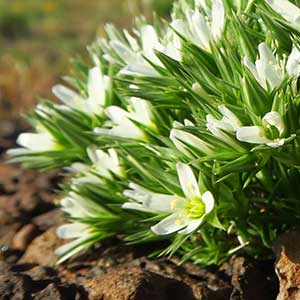Eremogone franklinii
Eremogone ursina
Franklin's sandwort
Bear Valley sandwort, Big Bear Valley sandwort
erect, 3–10(–15) cm, glabrous.
ascending to erect, 10–18 cm, often glandular-hairy.
basal leaves persistent;
cauline leaves in 6–10 pairs, closely overlapping, not reduced;
basal blades arcuate-spreading, needlelike, (0.6–)1–2 cm × ca. 1 mm, ± rigid, herbaceous, apex spinose, glabrous, not glaucous.
basal leaves persistent;
cauline leaves in 3–5 pairs, reduced distally;
basal blades erect to ± spreading, needlelike, 0.5–1.1(–1.6) cm × 0.5–0.7 mm, rigid, herbaceous, not fleshy, apex blunt to apiculate, glabrous, ± glaucous.
3–45+-flowered, usually congested, subcapitate cymes.
(1–)3–7-flowered, ± open cymes.
ca. 0.1–3(–4) mm, glabrous.
0.3–2 mm, stipitate-glandular.
sepals 1–3-veined, linear-lanceolate, (5–)8.5–12 mm, not enlarging in fruit, margins narrow, apex acuminate, glabrous;
petals white, oblong-lanceolate to narrowly spatulate, 7–9 mm, 0.8–1.1 times as long as sepals, apex rounded to blunt;
nectaries not apparent.
sepals 1–3-veined, lateral veins less developed, ovate, often broadly so, 1.8–3 mm, to 4.2 mm in fruit, margins broad, apex obtuse or rounded, glabrous;
petals white, elliptic to oblanceolate, 2–4.5 mm, 1.4–1.6 times as long as sepals, apex rounded;
nectaries as lateral and abaxial rounding of base of filaments opposite sepals, with terminal lateral groove, 0.3 mm.
2.3–3.3 mm, glabrous.
4.5–6 mm, glabrous.
black, pyriform, 1.2–1.7 mm, tuberculate.
blackish purple, suborbicular to broadly ellipsoid with hilar notch, 2.2–2.5(–3) mm, tuberculate;
tubercles rounded, elongate.
Eremogone franklinii
Eremogone ursina
Varieties 2 (2 in the flora).
(Discussion copyrighted by Flora of North America; reprinted with permission.)
Of conservation concern.
Eremogone ursina is known from four counties in southern California, where it is threatened by development. It is relatively distinctive in appearance and markedly separated spatially from congeners.
(Discussion copyrighted by Flora of North America; reprinted with permission.)
1. Inflorescences tightly congested cymes; pedicels 0.1-1(-3) mm; sepals 8.5-12 mm; petals 0.8-0.9 times as long as sepals | var. franklinii |
1. Inflorescences somewhat congested cymes; pedicels 1-4 mm; sepals 5-8 mm; petals 1-1.1 times as long as sepals | var. thompsonii |
- Local floras:
OR,
WA
- Local Web sites:
CalFlora,
CalPhotos,
Flora NW,
PNW Herbaria
WildflowerSearch
iNaturalist (observations)
- LBJ Wildflower Center
- SEINet
- Plants of the World Online
- Encyclopedia of Life
- Wikipedia
- Google Image Search


